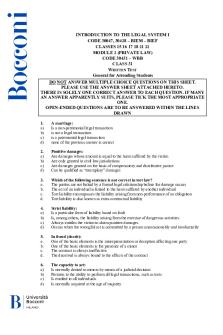MOCK EXAM - Summary Introductory Neuroscience PDF

| Title | MOCK EXAM - Summary Introductory Neuroscience |
|---|---|
| Author | Jack Chilton |
| Course | Introductory Neuroscience |
| Institution | Loughborough University |
| Pages | 5 |
| File Size | 103.4 KB |
| File Type | |
| Total Downloads | 40 |
| Total Views | 142 |
Summary
Mock exam based on the entire module...
Description
PSA301 Revision Questions 1. Neurons are: a) A type of excitable cell b) Able to respond to stimulation c) Able to communicate to other neurons via synapse d) All of the above 2. Which of the following statements is correct? a) There are more neurons in the brain than glial cells b) There are an equal proportion of neurons and glial cells in the brain c) There are more glial cells than neurons in the brain d) There are no glial cells in the brain 3. The part of the nerve cell specialized for conducting information is the: a) Axon b) Cell body c) Dendrites d) Nucleus 4. The conduction of a nerve impulse along the axon is called the: a) Ion potential b) Resting potential c) Synapse d) Action potential 5. Many of the cells of the nervous system carry a negative charge due to unequal concentrations of ions inside and outside the cell. This is known as: a) Action potential b) Resting potential c) Equilibrium potential d) Energy potential 6. The concentration difference of ions between extracellular and intracellular fluid causes ions to tend to: a) Move from regions of high concentration to regions of low concentration b) Vibrate c) Move from regions of low concentration to regions of high concentration d) Progress towards the axon terminals 7. In a resting neuron, which of the following ions are found in a greater concentration inside the neuron? a) Clb) Na+ c) K+ d) Ca2+
8. The function of the myelin sheath is to: a) Protect the axon b) Protect the nodes of Ranvier c) Protect the sodium pump d) Affect the speed of the transmission of the impulse 9. Which statement below is correct? a) A synapse is a junction between two neurons b) Information travels from dendrites of one neuron to axon of another c) Electrical information is carried across the synaptic gap d) All of the above 10. Alteration of the post-synaptic membrane potential can cause which of following? a) Depolarisation b) Hyperpolarisation c) Stabilisation d) All of the above 11. Which of the following is NOT a monoamine neurotransmitter? a) Norepinephrine b) Glutamate c) Dopamine d) Serotonin 12. Schizophrenia is associated with which neurotransmitter? a) Acetylcholine b) Glutamate c) Norepinephrine d) Dopamine 13. Which of the following is NOT part of the peripheral nervous system? a) Cranial nerves b) Spinal nerves c) Spinal cord d) Peripheral ganglia 14. Transmission of a simple nervous system circuit occurs in which of the following orders? a) Receptors, afferent neurons, central nervous system, efferent neurons, effectors b) Effectors, afferent neurons, central nervous system, efferent neurons, receptors c) Receptors, efferent neurons, central nervous system, afferent neurons, effectors d) Effectors, efferent neurons, central nervous system, afferent neurons, receptors
15. Interneurons are also known as? a) Afferent neurons b) Relay neurons c) Efferent neurons d) Junction neurons 16. Which of the following are found in the peripheral nervous system? a) Cell body of sensory neuron b) Axon terminal of sensory neuron c) Cell body of motor neuron d) Dendrites of motor neuron 17. Which of the following is NOT a cranial nerve? a) Olfactory nerve b) Vagus nerve c) Facial nerve d) Femoral nerve 18. The white matter in the spinal cord contains? a) Myelinated axons b) Interneurons c) Glial cells d) Axons of afferent neurons 19. Which of the following is a division of the autonomic nervous system? a) Sympathetic nervous system b) Enteric nervous system c) Somatic nervous system d) Both A and B 20. The anatomical term caudal means? a) Bottom of the skull b) Towards back of skull c) Top of the skull d) Towards head / eyes 21. Which following part of the brain evolved earliest? a) Amygdala b) Thalamus c) Hypothalamus d) Brainstem 22. How many cranial nerves connect to the brainstem? a) 8 b) 10 c) 12 d) 14
23. The relay of visual information from the retina to the motor neurons of the eyes, head and neck is performed by which structure? a) Red nucleus b) Inferior colliculus c) Superior colliculus d) Substantia nigra 24. Over 50% of the brains neurons are contained within? a) Telencephalon b) Diencephalon c) Brainstem d) Cerebellum 25. Which of the following is the correct description of the transverse anatomical brain plane section? a) Slice through brain parallel to ground b) Slice through brain parallel to neuraxis & perpendicular to the ground c) Slice through brain parallel to forehead giving cross sections d) Slice through brain diagonally to neuraxis at 45o 26. Which of the following is the most dorsal part of the diencephalon? a) Hypothalamus b) Thalamus c) Pituitary gland d) Optic chiasm 27. Which of the following is NOT true of the Endocrine System? a) It is a collection of glands b) It transports hormones in the blood c) It is quicker than the nervous system d) It is mostly controlled by hormones produced by the hypothalamus 28. The posterior pituitary gland is considered an extension of which structure? a) Hypothalamus b) Optic chiasm c) Lateral geniculate nucleus d) Medial geniculate nucleus 29. Which of these statements are true? a) The cerebrum is divided into 2 symmetrical hemispheres b) The left hemisphere controls the right side of the body c) The right hemisphere controls the left side of the body d) All of the above 30. White matter is composed of? a) Myelinated axons b) Cell bodies c) Dendrites d) Glial cells
31. The Primary Somatosensory cortex is found in? a) The occipital lobe b) The temporal lobe c) The parietal lobe d) The frontal lobe 32. The limbic system is primary concerned with? a) Movement b) Emotions c) Speech generation d) Corpus callosum 33. The functions of the Cerebrospinal fluid include: a) Protection of the brain b) Removal of waste from the brain c) Transportation of hormones throughout the brain d) All of the above 34. The barrier that serves as a protective filter to regulate entry of chemicals into the brain is known as the: a) Meninges b) The blood–brain barrier c) The brain stem d) The cerebellum...
Similar Free PDFs

Mock exam
- 3 Pages

Mock Exam - exam
- 8 Pages

Mock Exam - exam
- 4 Pages

Neuroscience Exam 2 Content
- 12 Pages

SBL MOCK EXAM 1
- 16 Pages

Mock Final Exam - Questions
- 11 Pages

MECO1001 Mock exam 2019
- 6 Pages

Mock exam 2019-2020
- 8 Pages

Revision & Mock Exam
- 22 Pages

Mock Exam C250 - Mock test questions
- 34 Pages

2020 nutrition mock exam
- 5 Pages
Popular Institutions
- Tinajero National High School - Annex
- Politeknik Caltex Riau
- Yokohama City University
- SGT University
- University of Al-Qadisiyah
- Divine Word College of Vigan
- Techniek College Rotterdam
- Universidade de Santiago
- Universiti Teknologi MARA Cawangan Johor Kampus Pasir Gudang
- Poltekkes Kemenkes Yogyakarta
- Baguio City National High School
- Colegio san marcos
- preparatoria uno
- Centro de Bachillerato Tecnológico Industrial y de Servicios No. 107
- Dalian Maritime University
- Quang Trung Secondary School
- Colegio Tecnológico en Informática
- Corporación Regional de Educación Superior
- Grupo CEDVA
- Dar Al Uloom University
- Centro de Estudios Preuniversitarios de la Universidad Nacional de Ingeniería
- 上智大学
- Aakash International School, Nuna Majara
- San Felipe Neri Catholic School
- Kang Chiao International School - New Taipei City
- Misamis Occidental National High School
- Institución Educativa Escuela Normal Juan Ladrilleros
- Kolehiyo ng Pantukan
- Batanes State College
- Instituto Continental
- Sekolah Menengah Kejuruan Kesehatan Kaltara (Tarakan)
- Colegio de La Inmaculada Concepcion - Cebu




